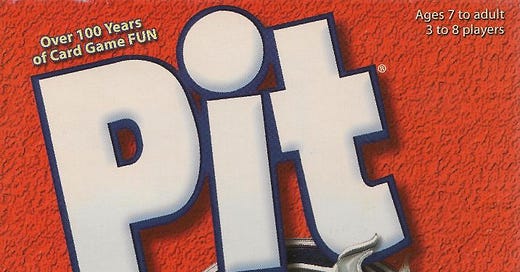I call it “The 20th Century Project” but let’s be honest, in terms of fun game past-times, the 20th Century wasn’t exactly front loaded. Mostly this is due to one hundred years of economic improvements: as the world got wealthier and costs dropped it became easier to make games and people had more time to play them.
Not that people didn’t play games … they just didn’t buy them nearly as much. Back then Games meant word games or athletic events or things games you could play with no equipment (“I Spy, with my little eye”). Or the equipment would be simple and standard: cards or dice, or a backgammon or chess set. The history of board games bought in stores certainly started before the Twentieth Century, but it grew slowly. Nowadays thousands of games are released each year, which dwarfs the numbers I remember from my childhood, and as you go back in the past those numbers keep getting smaller and smaller.
But even with those few games, sometimes lighting struck.
Pit might have been designed by famed psychic Edward Cayce: he certainly claimed he’d designed it and sent it to Parker Brothers. But he hadn't bothered protecting his Intellectual Property (if his it was) and Parker Brothers simply printed it and didn’t pay him or credit him. (How he reconciled this fact with his profession as ‘psychic’ isn’t reported).
The gameplay of Pit is simplicity itself. There are various suits of cards (typically each with nine) and players have a hand of 9 or 10 cards and can blindly trade them, loudly and quickly without mentioning the suits “I’ve got 4! 4! 4!” and if you find a taker you quickly swap cards, re-sort and keep going until one player has all of a single suit (‘Cornered the market’) and claims victory.
Pit is fast, loud, and reminiscent of a commodities trading floor.1 And if you are a fan of quiet you don’t want to play a version that requires you to ring a bell loudly instead of shouting “Corner” to end the round.2
Pit is often compared to Gavitt’s Stock Exchange (by Henry Gavitt), who had enough foresight to protect his intellectual property with multiple patents and a copyright (starting in the 19th Century). But G-S-E (as the box itself called it) threw in a bunch of other rules that Cayce (or Parker Brothers, or whoever …) simply did away with in Pit and stripped it down to it’s Platonic Ideal. Get Cards - Shout - Swap - Repeat - Ding!
I mean, Pit has a scoring system. It keeps changing in various editions. Nobody cares. Like the picture above says, it’s still been printed and sold today. Not bad for a game pushing 125 years old; keeping up with the videogames and $500 kickstarter boardgames that weigh 20 pounds and take up three tables.
Pit represents what games used to be and sometimes still are: simple, boisterous events where people gather around a table (or run around a room) shouting and screaming until it’s over and the recriminations begin3.
Pit strikes me as a one of the Most Influential Games of the 20th Century. As “Games” are now defined as “videogames” or “boardgames” or “roleplaying games” it is still around to remind us that games are not always cerebral events (or fast twitch events), but sometimes are simply loud ways to pass the time, and that hasn’t totally died out even in the 21st Century.
I mean, I’ve never seen one. But I saw Trading Places and it was actually filmed at the COMEX commodity exchange (now called NYMEX). Come for the games, stay for the film trivia.
The again, I suppose it depends on how loudly they shout.
Just like actual trading floors.





